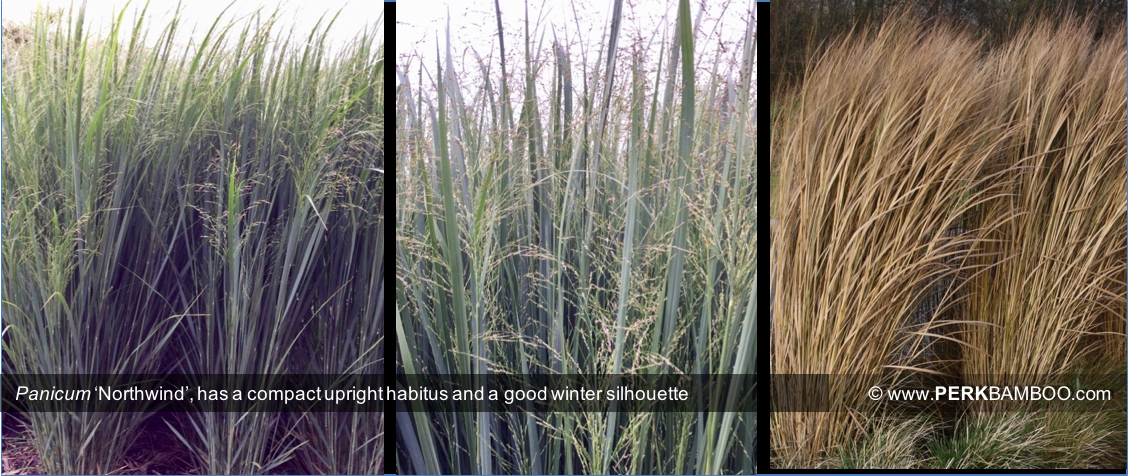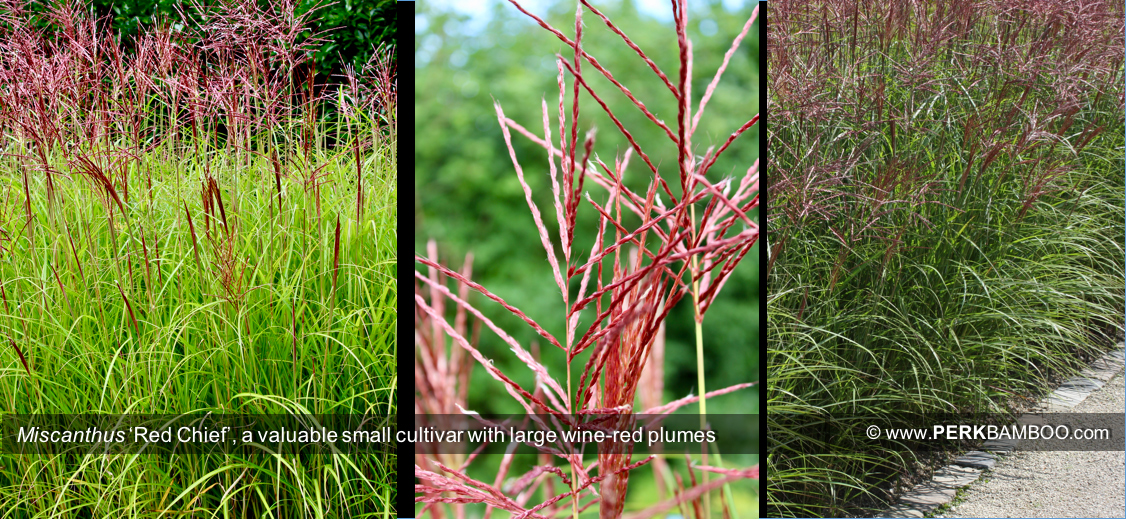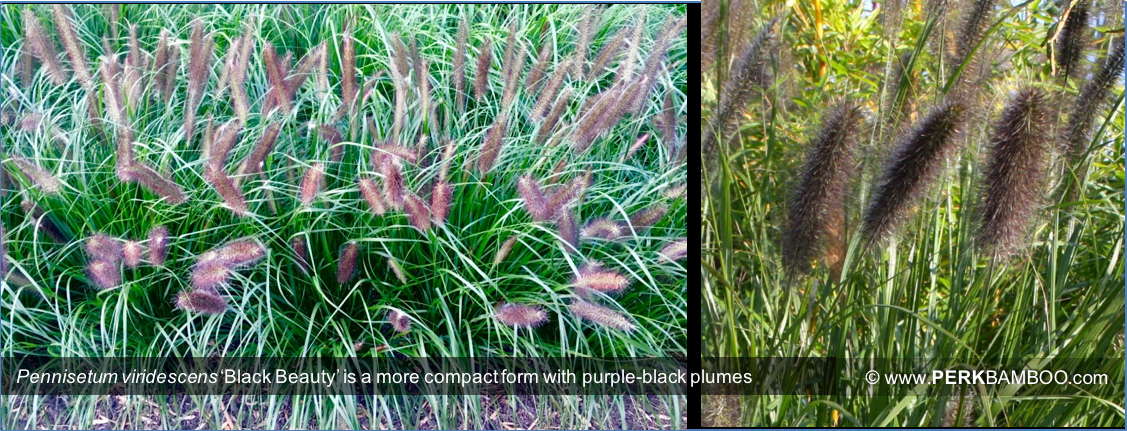STRUCTURE GRASSES
WINTER SILHOUETTE
Although most ornamental grasses between 50-200cm are not evergreen, they are still well worth it in winter. The winter silhouette of Miscanthus for example in the form of a solid bundle of straw yellow culms, adorned with silvery plumes reminiscent of the atmosphere of the old Dutch reed landscape. The vertical lines of the stalks and frost on the feathers create a special atmosphere. Besides that grasses provide shelter and habitat for various species of birds and mammals.
Think of Pennisetum, with a series of cultivars. Unfortunately, many Pennisetum's less suitable for moist soils (clay, peat) with too much moisture in the winter can lead to failure. Pennisetum alpecuroides ‘Black Beauty' and 'Japonicum' do clearly better under these conditions. Panicum (pearl millet) has blue-gray-leaved types ( 'Heavy metal', 'Cloud Nine', 'Northwind') and all green shapes with red leaf tips in summer (‘Rehbraun’, ‘Rotstrahlbush’). Characteristic are the open panicles with very fine dancing 'gems' in the plume. Calamagrostis has a great diversity of form. The diamond grass, Calamagrostis brachytricha (synonym Stipa calamagrostis) has a rich bloom with fairly large, tapering panicles while Calamagrostis x acutiflora ‘Karl Foester' and ‘Overdam ‘ rave upright with long, spike-shaped inflorescences. In autumn the fine plumes catch dewdrops exhibiting a wonderful sparkle in autumn sun. Molinia (moor grass) is characterized by low soft green leaves which later in the summer to autumn a fountain of flowering culms which are arrayed to the top with thin spikes. The height of the fountain varies per cultivar ( 'Karl Foester', 'Wind Saule). A beautiful winter picture sadly missing in this species. Other good varieties are Spodiopogon sibiricus, Uniolia latifolia with very nice, flat ears and of course the rich diversity of forms of Miscanthus, ranging from the small shapes 'Yakushima Dwarf', 'Kleine Silberspinne’ and ‘Red Chief’ to the larger forms like 'Malepartus', 'Poseidon', "Goliath" and “Gewitterwolke, just to name a few. Below interesting species are described in more detail:

Carex muskingumensis 'Silberstreif' is characterized by the silver-white leaf margins. This gives the plant a lightening effect. Palm sedge is 40 to 60 cm high and is a striking ornamental grass because of the very narrow leaves, symmetrically arranged. The fine texture of this plant can be combined with other grasses and large-leaved plants in the area. The initially bright green leaves turn later in the season to medium green. Palm Sedge can be used both in the sun and in more shaded habitats, provided the soil is sufficiently moist. This plant is also applicable in planting containers. Very hardy, clumping but not evergreen. Cut the old foliage to the ground in early spring.
The dwarf cultivar Carex muskingumensis 'Little Midge' is perhaps most interesting selection to apply as low ground cover. The same appearance in green, but even with a finer texture.
Hakonechloa macra 'Aureola' is a graceful grass with a special appearance. It has bamboo leaves. It grows in any place that is not too dry in sun to partial shade. Eminently suitable for pots and containers, but also along paths, the graceful habit is in place. In autumn the foliage turns yellow to orange. The clumps can reach 30 cm in diameter at a height of 20-30 cm. In the summer this ornamental grass flowers with numerous fine plumes between the foliage.
Hakonechloa macra 'Allgold' has lime green leaves. Despite the lack of chlorophyll this variety is a strong and vigorous grower.'Allgold' is capable to light up a dark spot in the garden. A very valuable cultivar!
Hakonechloa macra is the botanical form which is larger in all parts and more vigorous. Very useful species in order to apply in groups or along edges due to the layered, fountain-like leaf structure. After winter cut the old foliage short to the ground.

Imperata cylindrica 'Red Baron’, Japanese Blood Grass is one of the most characteristic grasses with blood-red leaf coloring. Imperata starts to growth relatively late in the spring, is initially green and discolors during summer to deep red. Imperata prefers sun and a not too wet soil. The outgrowth height is 30-40 cm. It is a great accent plant, for example in combination with Black Snake Beard. Japanese blood grass has a color almost at the other end of the spectrum. Sometimes we also have the smaller form Imperata cylindrica 'Rubra'. This type is 20 to 30 cm high.
Imperata cylindrica ‘Koenigii’ Japanese rice grass is a larger relative of the Blood Grass. This form is 50-70 cm tall and has a soft emerald green color. Only in autumn the leaves turn to purple-red hues. The hardiness is good as long planted on a humus rich, well drained soil in full sun. Imperata not flower in our climate. After winter cut back the old foliage to the ground.
Japanese Silver Grass (Miscanthus)
I have always been impressed by Japanese Silver Grass (Miscanthus). The numerous types and forms within Miscanthus are a world in itself. In the 90s I built a large collection of all available species, hybrids and selections and observed them. Nowadays a limited number of species and cultivars are part of the nursery stock after selection, based on ornamental value, winter silhouette and climate suitability. Especially the graceful narrow-leaved cultivars I regularly apply into my designs. The following types are usually available at the nursery, often immature to adult sizes. Heights are indicative; local factors and climate may lead to a different size. Nowadays names of Miscanthus cultivars have been mixed up a lot in trade, making it difficult to obtain the right plants. The cultivars we have collected ourselves come from reliable resources and propagations are only made from these original plants.

Miscanthus 'Kleine Silberspinne’ is a sturdy clumping grass, with very fine foliage, rich flowering and a limited height. The growth height is 1.00 to 1.50 m including plume. It flowers in August and September with narrow copper red plumes which later fade to silver. The foliage is undergoing a pretty autumn coloration over golden yellow to orange-red.
Miscanthus ‘Silberspinne' is a size larger (1.50 - 1.75 m) with a very rich inflorescence; Initially copper and deliquescent to silver. Full bushy plants
Miscanthus 'Champagne' is a narrow-leaved cultivar with striking bright green leaves and a blonde plume that does justice to its name. As nights get colder in autumn, the latest plumes turn to rosé. Here it grows between 150-170 cm high.
Miscanthus 'Graziella' for me is one of the most valuable narrow-leaved cultivars. 'Graziella' is a transparent sea green plant with very narrow leaves with a silver midrib. The culms are frosted and color purple in full sun. Open copper plumes complete the growth cycle and turn to silver. Height 150-170.
Miscanthus 'Sarabande’ can be seen as a bloom willing variant of ‘Gracillimus'. Grows more elegant upright. 160-190cm
Miscanthus 'Adagio' is a small narrow-leaved cultivar with light pink red-tinted plumes, not too big; 120-150cm
Miscanthus 'Red Chief' is an important new type that combines a number of special features: compact (ca.100-140cm), vital and rich flowering with thick copper-red plumes like we know from 'Malepartus'. Finally enough stock to offer.
Miscanthus 'Kaskade' is a medium-sized species (150-180cm) with 1 cm leaf. Typically, the gracefully drooping panicles that determine the ornamental value of this cultivar. Beautiful as solitary or in groups.
Miscanthus 'Vorläufer' first blooms in summer (mid-July) with pointed red tinted plumes later discolor to silver. The medium wide leaves without a midrib grows somewhat lower in the crop. Foliage height 50-75 cm, with plumes upto 150 cm.
Miscanthus 'Variegatus' has striking white-green-banded leaves. This grass can be used as solitary or in groups on a dark background, or in combination with red-leaved plants. Very hardy. The growth height is of 1.50 - 1.75. 'Variegatus' flowers in a good summer in late September with copper red plumes that turn silvery later on.
Miscanthus 'Kleine Fontaine' is a hit among the half-height Miscanthus-selections. This ornamental grass makes a strong compact clump. The growth height is around 1.50 m including plume. The bloom is developing like a fountain; while the first plumes are already well above the foliage the new flowering panicles come already from inside the plant to develop. ‘Kleine Fontaine flowers in late July to October with pinkish plumes which later fade to silvergrey.
Miscanthus 'Morning Light' is one of the most outstanding selections of Miscanthus. This form from Japan has very narrow leaves with silvery white edges and midrib. This creates a strong lightening visual effect. 'Morning Light' is useful solitary or in groups with a dark background for example in combination with red-leaved plants. Growth height is 1.50 - 1.80m. Blooms only after a warm summer in late autumn with copper red plumes.
Miscanthus 'Yakushima Dwarf' is a solid dwarf selection from Japan. The growth height is 80-120 cm. 'Yakushima Dwarf' very fine textured leaves, adorned with many reddish brown plumes in late summer.
Miscanthus 'Gracillimus' is a popular plant for landscapers because of the very fine leaves and upright growth habit 160-180 cm. Add to that the transparent appearance and the soft movements in the breeze and you have an ideal plant for modern gardens with. Designer Dick Beijer uses this species because of the (most years) failure to bloom in our climate, which fits in perfectly with his minimalistic designs.
Miscanthus 'Herman Mussel’ is a rich flowering form and resistant to late frosts. This selection is named after the director of the botanical garden in Munich by Max Riedelsheimer. Not without reason, because it is one of the most vital growing species. The relatively narrow leaf growing in a dense group into an almost circular shape (125-170cm). In late summer, this plant is adorned with a massive amount of golden plumes that turn later to silver. A very recommendable species as solitary or in groups.
Miscanthus 'Malepartus' grows upto 1.80 to 2.00 m including plume. 'Malepartus' blooms in August and September with large copper red plumes which later fade to silver. The broader leaves undergoes a beautiful autumn coloring over golden yellow to orange-red. Definitely one of the best ornamental grasses with broader leaves.

Miscanthus sacchariflorus 'Gotemba Gold' is a new, very beautiful, spreading ornamental grass with broad yellow-green-striped leaves, imported by Barry Yinger from Japan. Notable features are the purple red stems which form a beautiful contrast with the wide, yellow variegated leaf which has a silver midvein. We have never been observed flowering. In small gardens, it is advisable to plant this species within a ring of root barrier. Also usefull in planting containers. The height is between about 150-175 cm.
Miscanthus condensatus is a big (2+m), broad-leaved species. Growth is more compact, rigid and leaves looks firmer. The green form is available under the name Miscanthus condensatus 'Emerald Giant'. There are two variegated cultivars. The variegated-striped form Miscanthus condensatus 'Cosmopolitan'. A graceful plant with green dominating the white lined leaf. The yellow-green-striped selection Miscanthus condensatus 'Cabaret'. Both variegated cultivars remain somewhat smaller compared to the green form. It's a nice solitary species with a large bright pinkish-red inflorescence in late autumn.

Molinia caerulea 'Moorflamme', 'Transparant'
Pennisetum, bottle brush grass is a typical grass for open growth location with lots of light. Commonly available selections such as “Herbstzauber' and 'Hameln’ are out of our collection due to greater sensitivity. Of the many species and varieties wich dropped out after wet winters the following forms with large, dark plumes showed the best results. This is Pennisetum var. Japonicum with its own character. This beautiful plant grows into a sturdy clump of 100-140 cm high and is in late summer to early winter, adorned with many very dark, exceptionally large plumes. Preferably full sun to partial shade (then flowering is later). Proved well hardy even on more moist and compact clay soils. The cultivar Pennisetum viridescens 'Black Beauty' blooms a few weeks earlier, also with purple-black plumes and has a finer structure and grows lower, about 75-100 cm.


Panicum 'Heavy Metal', 'Northwind', 'Thundercloud'

Stipa calamagrostis (syn. Achnatherum brachytricha, Calamagrostis brachytricha), Diamond Grass is a striking clumping ornamental grass with rich flowering in late summer and autumn. The long, fine plumes easy catch dewdrops whereby the plumes sparkle in the morning light. Hence the name diamond grass. Strong, first upright growing, later slightly overhanging with a beautiful winter picture, 90-140 cm high. End of winter prune back to ground level before new growth begins. Sun to partial shade.
Stipa gigantea, Portuguese Giant Oat is a strong, evergreen plant. In summer, large transparent flower plumes show up. It is a striking decorative element in any garden; the open plumes dancing on the wind (2m). This ornamental grass also has a beautiful winter picture with the remaining leaves and stalks swaying in the wind. Stipa gigantea forms dense clumps with foliage height of 40 cm. Stand full sun on a warm, well-drained soil. After a harsh winter the leaves can freeze back. A pruning in the spring does quickly forget this. Stipa gigantea can also be used in larger tubs and planters.
Uniolia (Chasmanthium) latifolia (Mexico, USA) is a clumping grass with bamboo-like leaves, lovely structured with a rich flowering in late summer and autumn. Striking is the rich green color of the broad leaf. The inflorescence is still the most particular; countless flat spikes, changing to red copper, dancing in the wind on thin culms. A beautiful ornamental grass to convert into view along the terrace or in pots. Grows up to 70-100 cm. The autumn coloring has orange and yellow tones. Also it has a nice winter image. End of winter cut of the old leaves before new growth begins. Sun to partial shade.


